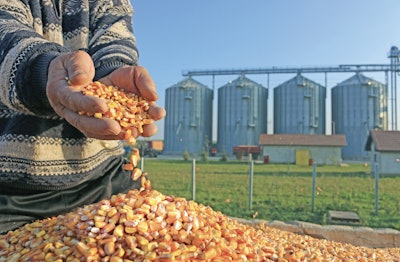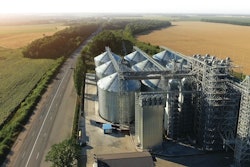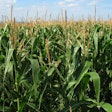
Who wants to be better than average? Simply being better than average doesn’t get you into Division I athletics. It may not win you a competitive job. It certainly won’t make you one of the rich and famous. While it can lead to a measure of success, the “who’s who” and the honorable mentions are not made up of those who simply sought to be better than average. But what if simply being better than average is necessary for survival?
Agriculture is inherently dangerous business. It can be dangerous to you or your employee’s health. You expose yourself to a product that is greatly affected by weather and therefore carries an extreme amount of risk. You invest your capital in land, equipment and people to add value to market and all of these put together deter those with little to moderate resolve from venturing into agriculture. Those that do not only stand up to risk but also can get comfortable sleeping with it. Considering all these risks, farmers, elevators and end-users choose to invest their valuable resources in a risky commodity so that they, at the end of a season, have grown their assets.
Let’s look at farmers. They take risk on the land they buy or rent. They take risks with inputs including seed, fertilizer, herbicide, pesticide and more. They take risk in pricing those inputs. They take risks on planting dates. They take risk in financing their operation and on the future of their livelihood for themselves and their children. More risks could be listed, but the fact is farmers are not averse to risk.
It is no surprise, then, that this shows up in farmer marketing practices, as well. While many utilize crop insurance programs that can certainly dull the pain of catastrophic crop failure and even add a boost in poorly performing crops or markets, there is still a sizable amount of opportunity and risk in marketing grain. I talked to a farmer the other day who had some of his 2017 crop in the bin, little of his 2018 crop priced and certainly was not thinking about a plan for 2019 crop. Some are in similar situations with grain on storage or price later from 2017 and not having much sold for 2018. These examples are not uncommon and show the willingness some have to carry price risk on their crops.
Risk taking is necessary, but if you look at the last 20 years of USDA data, you would find some troubling results.
According to USDA data, the average cost of production over the last 20 years is greater than the average yield times average price received by farmers in most years for corn and soybeans. Average corn cost was greater than average revenue 12 years. Average bean cost was greater than average revenue 11 years.
This tells us that most years the average cost/acre is not being covered by the average revenue/acre. In all years corresponding harvest futures reached profitable levels except for 2000-2002 for beans. Profitability was available more than these charts show. The key to locking in those prices was doing it well before harvest most years.
Most sell when they must, not when it is favorable. The fear of lost opportunity supersedes the fear of not covering cost. Whether time and space are no longer available, or the bills need paid, the decision is pushed back until they give up or they are forced.
Better than average is better than missing profitability. Shooting for the unreasonable expectation of hitting a high with most of their bushels is unrealistic. Better than average is not only a reasonable goal it also may be necessary for their livelihood.
If I was speaking to a farmer, here are a few steps I would give them in how they can make sure they do better than average.
Step 1: Kill ambiguity by defining success
Ambiguity is defined by dictionary.com as “the quality of being open to more than one interpretation; inexactness.” I’ve asked the following question too many times in marketing meetings, in regard to return on investment, “How much do you want to make?” Inevitably someone pipes up with, “As much as I can!” Well, that would be great, but what does this answer do for you? Nothing. It gives us no obtainable goal, no actionable data and leaves nothing but ambiguity in the air. Ambiguity breeds stress, and I think you have enough stress in your life.
I’ve stopped asking that question and started asking, “How do you define success on the farm?” Now, I usually have someone who will say that making more money than they started with is success. Good answer! Kill ambiguity by defining success for your farm each year. Take your known APH, known costs and set some reasonable profitable goals for your farm. Don’t just do it and throw in a drawer either. Pin it over your desk, put a sticky on your dash board or make yourself accountable to your family by using yet another magnet on the fridge. It’s that important and will help you act according to knowledge rather than emotion.
Step 2: Get ahead of your harvest
It is hard to be focused on next year’s crop when you’re worried about grain in the bin or on some type of storage. Moving from deciding what to do with unsold harvested grain to proactively pricing an unharvested crop can be a difficult change to make for some. As soon as the grain is on the combine, time and space are working against you. When you can put last years crop behind you, you’ll find it easier to keep your eyes ahead for opportunity.
While this is difficult, perhaps this is the year to get ahead. While prices are less than desirable, what does revenue look like with this years potential yield? While isolated areas might not have above average yield, it appears most regions do.
Take an honest look at yield expectation and apply it to your marketing plan. $3.50 corn at 180 bushel/acre is equivalent to 160 bushel corn at $3.94. Likewise, $8.25/bushel for beans at 58 bushel/acre is equivalent to 50 bushel/acre at $9.57. Simple math but not so simple to act on.
No one enjoys settling for lower prices than they could have locked in, but it sure beats $3.00/bushel for corn and $7.50/bushel for beans. We’re getting closer to these prices every day it seems. If these numbers are relevant to your farm, what makes sense? Figure it out, and while it can be difficult, take the profit and move on to next year.
Step 3: Take action for success
Be a seller of grain and not hoarder of grain. For several years prior to 2006, our family elevator worked hard to help farmers lock in profitable prices. We built a culture of sellers. Then, 2006 happened. I remember our local bid at 1.85 in late 2005 and we went over $3 in 2006 and have only seen that momentarily since. From 2006 to 2013, our customers resolve was challenged. It seemed that you were “penalized” if you were proactive in marketing your grain and those who did nothing capitalized on higher prices at harvest.
With forward contracts that were less than harvest prices, many felt defeated, though they were still at profitable prices and took advantage of higher prices with grain that was not contracted.
The challenge is overcoming the feeling like the contracted grain was a mistake; this impacts the good practice of forward contracting.
In our backyard, the last few years it was difficult to buy forward contracted grain. Fortunately, our trend is reversing. Many took advantage of this year’s spring pricing opportunities, and I believe this is true across the corn belt.
These past few years and our current situation remind us of how important being an aggressive seller of your crop has on success. Getting grain sold when the market provides profitable prices combined with not adding storage or stay-in-the-market costs will help you be better than average.
These steps are important. One, it can mean the difference between profitability and loss for our farmers. This impacts not only our businesses but also our families.
Second, it impacts our local community. Our farms are a natural resource that many rural communities rely on. While many rural businesses give way to large box stores, online buying and more, our communities are dependent on their local resources for viability now more than ever.
Our being better than average matters. Our quiet success means bringing more dollars into our businesses, into our homes and into our community. Not to mention the value of knowing you managed your business well and improved the quality of life around you.
Agriculture is risky business and we’re not afraid. So, let’s all strive to do our best to make sure we get paid. ❚


















